


 |
 |
 |

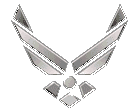
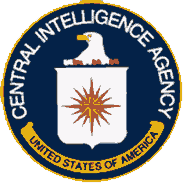


![]()
![]()
![]()
![]()
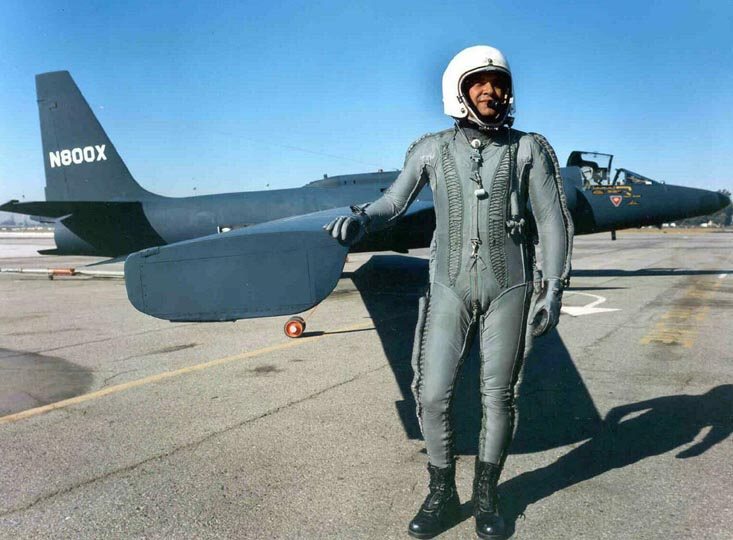
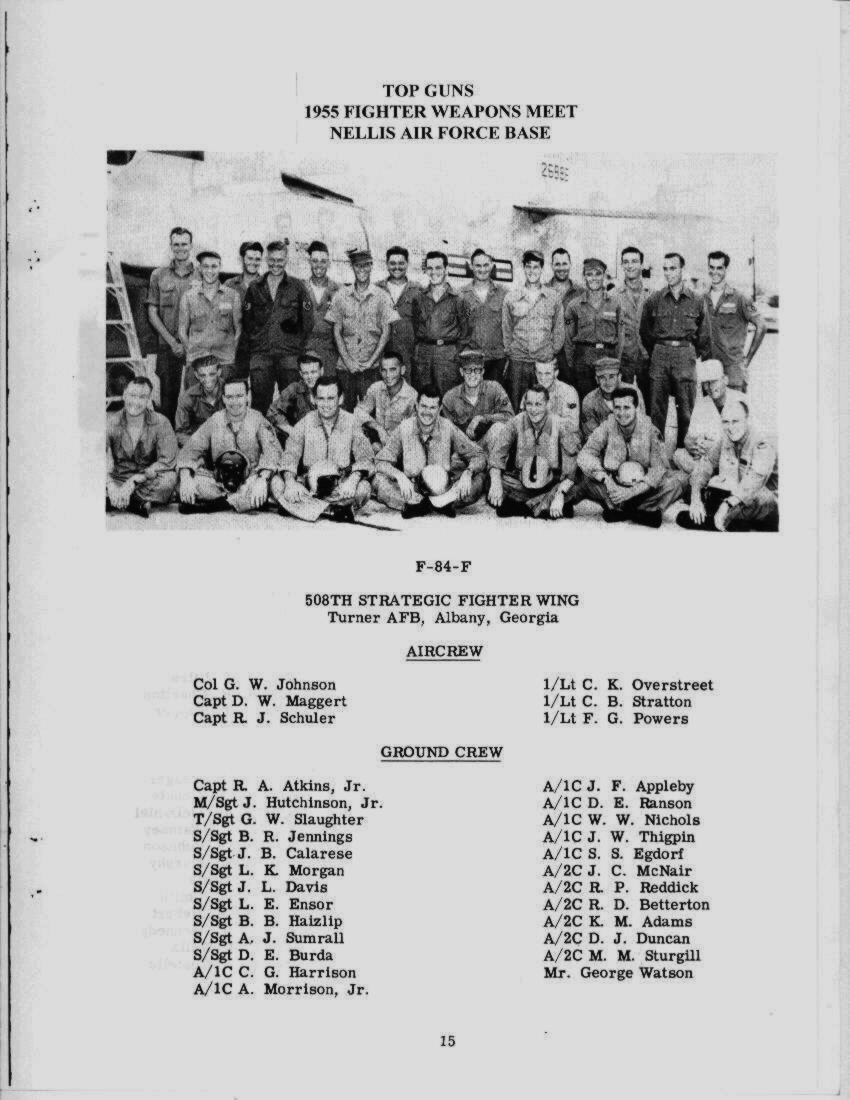
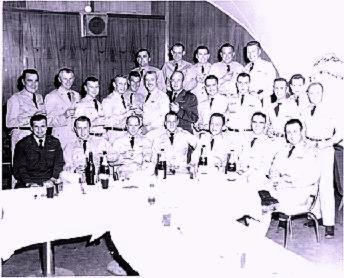 Born on August 17, 1929, in Burdine, Kentucky, Francis Gary Powers entered the U.S. Air Force in 1950 and the aviation cadet-training program in 1951. He earned a commission as a second lieutenant a year later. After completing his training, Powers flew F-84s while assigned to the 468th Strategic Fighter Squadron at Turner Air Force Base, Ga. He "left" the Air Force to work in the deepening shadows of the ultra-secretU-2 program in 1956 when the CIA recruited him. That year Powers joined five other men in Adana, Turkey to fly "weather missions."
Born on August 17, 1929, in Burdine, Kentucky, Francis Gary Powers entered the U.S. Air Force in 1950 and the aviation cadet-training program in 1951. He earned a commission as a second lieutenant a year later. After completing his training, Powers flew F-84s while assigned to the 468th Strategic Fighter Squadron at Turner Air Force Base, Ga. He "left" the Air Force to work in the deepening shadows of the ultra-secretU-2 program in 1956 when the CIA recruited him. That year Powers joined five other men in Adana, Turkey to fly "weather missions."
Powers was one of the men charged with the mission of flying on atmosphere's edge, at altitudes that designers and military experts thought 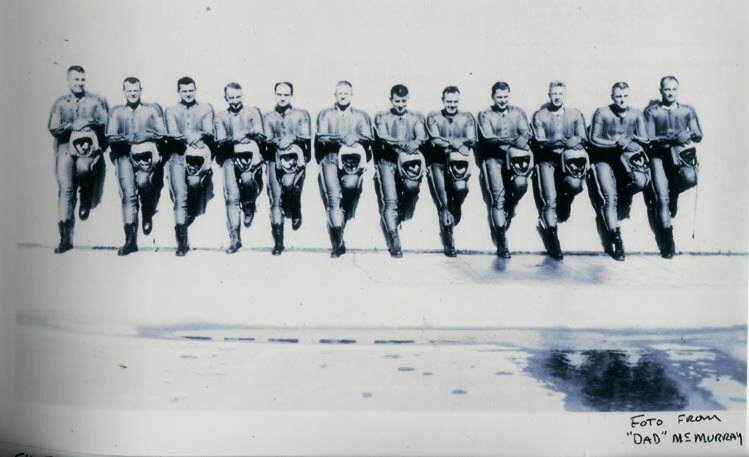 made these planes invulnerable to Soviet air defenses. On July 4, 1956, the
U-2 first flew over the Soviet Union taking photos of Moscow. The Soviet air defenses detected the flight but the U-2 flew too high for effective countermeasures. Later counter-spy efforts uncovered that Selmer Nielsen, a Soviet agent at the Bodo Air Base, routinely compromised the U-2 missions by turning over flight times and routes. In preparation for the Paris Summit Conference to be held on May, 16 1960, President Eisenhower ordered that no U-2 flights could take place after May 1, 1960.
made these planes invulnerable to Soviet air defenses. On July 4, 1956, the
U-2 first flew over the Soviet Union taking photos of Moscow. The Soviet air defenses detected the flight but the U-2 flew too high for effective countermeasures. Later counter-spy efforts uncovered that Selmer Nielsen, a Soviet agent at the Bodo Air Base, routinely compromised the U-2 missions by turning over flight times and routes. In preparation for the Paris Summit Conference to be held on May, 16 1960, President Eisenhower ordered that no U-2 flights could take place after May 1, 1960.
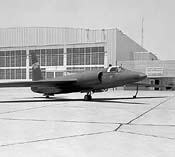
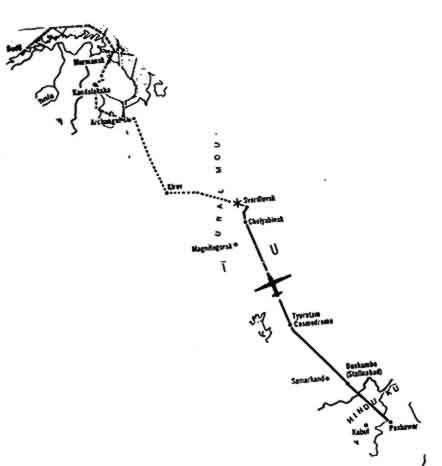 On May 1st, 1960, Powers took off from an air base outside of Peshawar, Pakistan. He crossed over the Soviet border at his assigned altitude and flipped the switches that would activate the reconnaissance cameras. He stayed on course, maintained radio silence, and was about 1300 miles within the Soviet Union when there was a bright orange flash at his altitude of 70,500 feet. One of fourteen Soviet SAM-2 missiles fired by the military exploded near the fragile tail section of the aircraft.
On May 1st, 1960, Powers took off from an air base outside of Peshawar, Pakistan. He crossed over the Soviet border at his assigned altitude and flipped the switches that would activate the reconnaissance cameras. He stayed on course, maintained radio silence, and was about 1300 miles within the Soviet Union when there was a bright orange flash at his altitude of 70,500 feet. One of fourteen Soviet SAM-2 missiles fired by the military exploded near the fragile tail section of the aircraft.
Everything appeared to be in order until the plane nosed down and wouldn't respond to the controls. A few seconds passed before Powers realized that the plane had been severely damaged. He thought about activating the destruct mechanism, but first had to prepare himself to use the ejection seat. The pilot had only 70 seconds after activating the destruct mechanism to get out of the aircraft. They were told to wait until the very last minute -- for obvious reasons.
However, when Powers was ready to eject, he realized he had been thrown back in his seat in 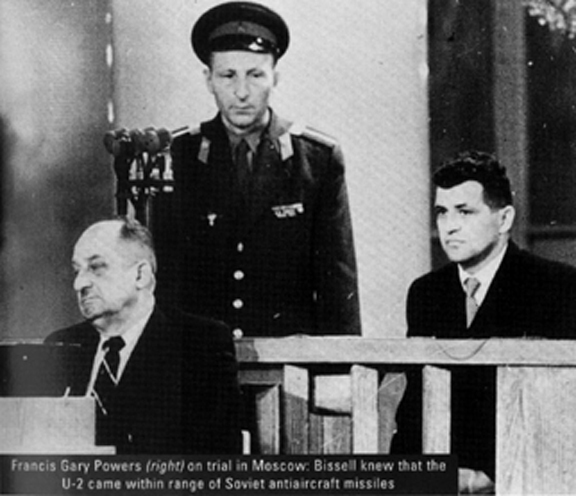 such a way that if he used the ejection mechanism, both of his legs would be severed. He decided to release the canopy and attempt to crawl out. When the canopy was clear of the plane, he undid his seat belt and was immediately propelled up over the front of the cockpit. Still connected by his air hose, he struggled to reach the destruct mechanism. Realizing he was getting closer to the Earth, Powers broke free of the air hose and fell clear from the plane.
such a way that if he used the ejection mechanism, both of his legs would be severed. He decided to release the canopy and attempt to crawl out. When the canopy was clear of the plane, he undid his seat belt and was immediately propelled up over the front of the cockpit. Still connected by his air hose, he struggled to reach the destruct mechanism. Realizing he was getting closer to the Earth, Powers broke free of the air hose and fell clear from the plane.
As fate would have it, he parachuted into the outskirts of a populated city, Sverdlovsk. He was arrested and taken to Lubyanka Prison in Moscow where he was held and interrogated by the KGB.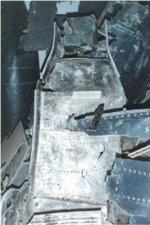
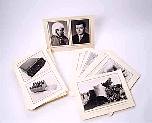
Knowing that the plane had not returned, and believing that Powers had died in the crash, the public information office in Turkey released the first of many cover stories that an "unarmed weather reconnaissance aircraft" had vanished during a routine flight, and that the pilot had reported trouble with his oxygen equipment. Other cover stories and rumors soon followed.
During this time, Powers was held in Lubyanka Prison where he was interrogated for 12 to 16 hours a day for 61 days. During his imprisonment, all kinds of misstatements, stories and cover-ups began appearing in the press.
The Soviet Union staged a widely publicized public trial for Francis Gary Powers that was designed to embarrass the United States, and Powers was sentenced to 10 years in a Soviet prison. He spent a total of 21 months in prison and was then exchanged in February 1962, for Soviet intelligence officer Rudolph Abel, who had been arrested in New York in 1957. This was the first and most dramatic East-West spy swap ever to occur in Cold War Berlin.
The Glienicker Bridge spans the Havel River near Potsdam and runs East-West. Potsdam is West of West Berlin and was in East Germany proper. On February 10 in 1962 at approximately 9 am Powers stepped on to the bridge. At the other end of the bridge, stood Colonel Rudolf Abel, a heavily muffled Soviet spy-master, seized earlier by US security agents after setting up a red spy network in New York in the late 1950s.
At a precisely arranged signal, the two men strode on to the bridge, marching purposefully towards one another, Powers heading eastward, Abel westwards. In the middle of the bridge they passed each other silently, with barely a nod of their heads. That spy-swap operation was to be the forerunner of many such East-West prisoner exchanges to take place on the Glienicker Bridge over the next 27 years.
Criticized when he returned to the United States for not ensuring the revolutionary plane was destroyed or killing himself with poison, Powers was extensively debriefed by the CIA and the designer of the U-2, Kelly Johnson. On March 6, 1962, he appeared in an open hearing before the Senate Committee on Armed Services, chaired by Senator Russell and including Senators Prescott Bush and Barry Goldwater, Sr.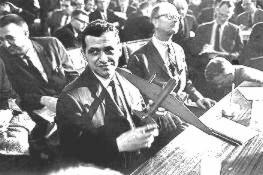
The Senate Committee exonerated him of any wrongdoing and called him "a fine young man performing well in a dangerous job." But, the government didn't clear up many of the false stories that had been circulated until many years later. There were many gaps between what the government knew and what it told to the public.
Some Americans questioned Powers conduct and loyalty. Many of the same people criticized President Eisenhower because the government was caught in a lie and made to look foolish in the eyes of the world.
Some people criticized Powers because he "didn't follow orders" and kill himself. In fact, there had never been any such orders. To the contrary, the CIA's instructions on capture were as follows: "If capture appears imminent, pilots should surrender without resistance and adopt a cooperative attitude toward their captors."
Others claimed he gave out vital information concerning the aircraft. In fact, the opposite was true; Powers gave no vital information, nor did he ever reveal the names of any of the pilots. Again, the CIA instructions were: "Pilots are perfectly free to tell the full truth about their mission with the exception of certain specifications about the aircraft."
Despite the Senate committee's clearance, despite the fact that he was awarded the highest honor the CIA can give, its Intelligence Star for valor, and the Air Force's Distinguished Flying Cross, Powers to borrow from John Le Carre, was the spy who was still out in the cold.
When President Eisenhower admitted that he had authorized the U-2 flights, it was one of the first times that the American people knew they had been deceived by their government and lied to by their President. After Nixon and Watergate, Johnson and Vietnam, Reagan and Iran Contra, and Monica and Bill, embellishment by Presidents is something the American public takes for granted.
Although it was for a necessary purpose that time, how many times do we get misinformation? How often is it justified?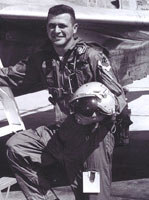
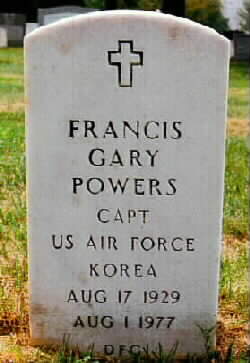
Powers died in 1977, at the age of 47, in the crash of a helicopter that he flew for K-NBC News in Los Angeles, California.
In 1998 at a CIA declassification conference on the U-2 program, CIA documents revealed that Powers' mission was a joint operation by the CIA and the Air Force. As a result on May 1, 2000, the fortieth anniversary of the U-2 Incident, the U.S. government (CIA and USAF) posthumously awarded the Powers family the medals denied to Powers while he was alive. Powers' family accepted the Department of Defense Prisoner of War Medal, National Defense Service Medal, and "The Director's medal" issued by George Tenet, Director of the CIA, during a ceremony at Beale Air Force Base in Northern California.
Speaking at the award ceremony, Brig. Gen. Kevin Chilton said, "The mind still boggles (over) what we asked this man to do: Fly in a plane "over downtown Moscow, alone, unarmed and unafraid, then to suffer in prison during what indeed was a war, the Cold War."
When asked how high he was flying on May 1, 1960, Powers would often reply, "Not high enough."
December 2011 - The U.S. Air Force will award a Silver Star posthumously to Francis Gary Powers, the pilot whose spy plane was shot down in 1960 over the Soviet Union in a defining moment of the Cold War. The Air Force determined that the U-2 pilot showed "steadfast loyalty" while under harsh interrogation in Soviet prisons. In a report obtained by The Associated Press, it cited his "sustained courage" and gallantry despite "cajolery, trickery, insults and threats of death."
The Silver Star is the Air Force's third-highest honor for service beyond the call of duty. Powers was swapped for a Soviet spy in February 1962 at Berlin's Glienicke Bridge. He died in the 1977 crash of a traffic helicopter he was flying in Los Angeles.
His son, Francis Gary Powers Jr., requested that his father be considered for the medal. He said the Air Force confirmed this week that it plans to award it. "It is vindication of my father 50 years afterwards," he said. "Dad is one of our American heroes.
In the aftermath of the downing, some people criticized Powers for not committing suicide using a toxin-tipped needle he was given before the flight. Powers said the CIA instructed pilots to surrender and to use of the poisoned pin only if they chose to while under torture.
Pilots were permitted to tell the truth about their missions with the exception of certain specifications of their aircraft. "While he admitted he was spying, he did not reveal any vital information to the enemy," said Powers Jr., founder of the Cold War Museum in Vint Hill, Virginia.
The decision to award the Silver Star comes just a few weeks before the 20th anniversary of the dissolution of the Soviet Union, on Dec. 25, 1991.
Powers was not honored after his return in 1962 because of the "global political environment," the Air Force report said.
The U-2 case was detailed in declassified data presented at a 1998 conference, and Powers was awarded a military POW medal and a CIA director's medal posthumously in 2000. The U-2 Soviet overflights were a joint CIA-Air Force program.
Powers Jr. said he requested his father be considered for the higher military honor a few years ago, citing honors given other captured spy plane pilots. He said no date has been set for the award ceremony.
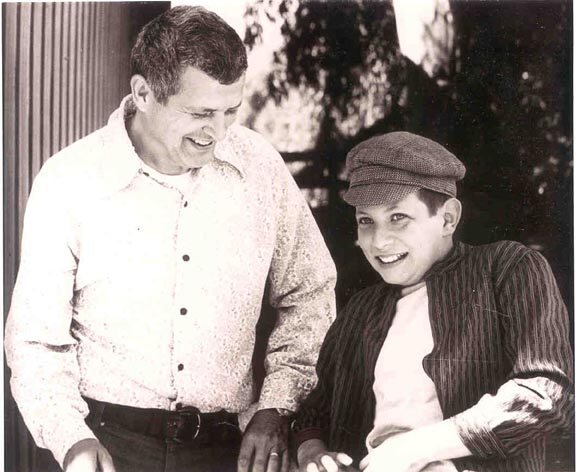
|
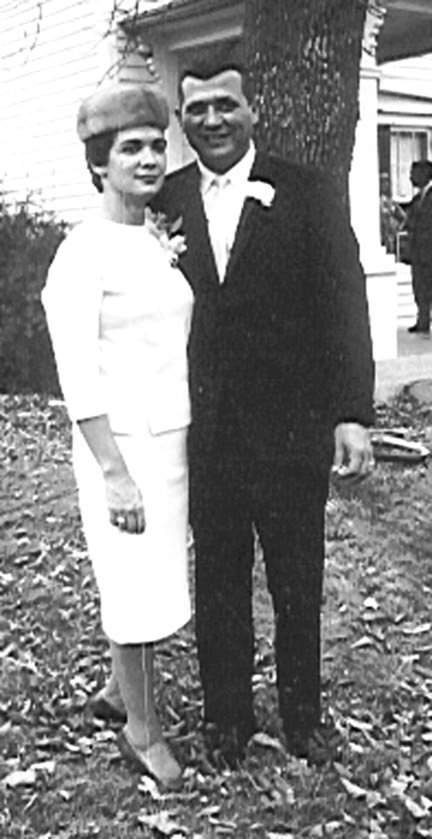 |
| Powers Family: Gary, Jr., Dee, Sue | Gary and Sue wedding |
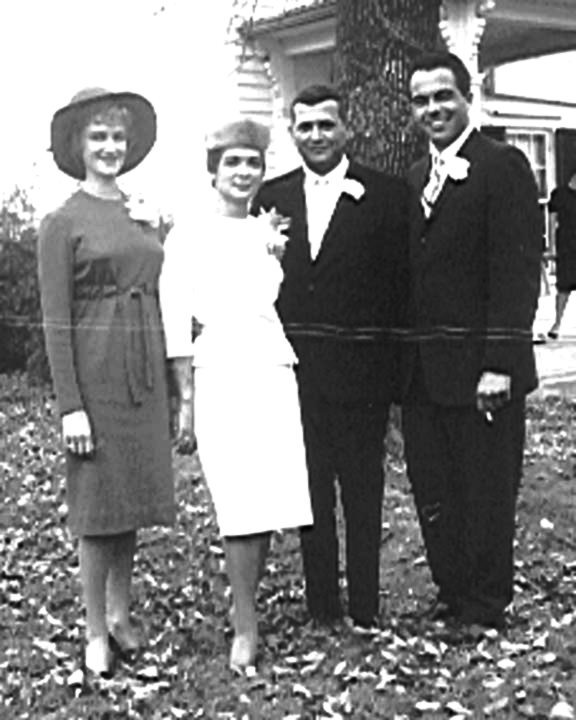
Gary and Sue's Wedding
L to R Edith Costello, Sue, Gary, Joe Giraudo
Roadrunners Internationales thanks Francis Gary Powers, Jr. for his contributions to this page
dedicated to the rememberance of his dad and one of our most esteemed Cold War aviator members.
After his dad's death, Gary Francis Powers, Jr. successfully fought for his dads recognition. Some of the documentation of his efforts are posted HERE
| Link to Transcript of Powers Debriefing |
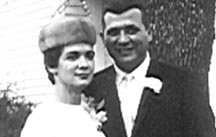 June 17, 2004. Sue Powers, widow of Francis Gary Powers, passed away at 1915 hours this evening at the Summerlin Hospital in Las Vegas, Nevada.
June 17, 2004. Sue Powers, widow of Francis Gary Powers, passed away at 1915 hours this evening at the Summerlin Hospital in Las Vegas, Nevada.
June 21, 2004 Update. Gary Powers Jr. has asked Roadrunner president Roger Andersen to post the following: A remembrance of Claudia "Sue" Powers will be held Saturday, June 26 from 1300 to 1500 hours at the Elks Lodge, 4100 W. Charleston in Las Vegas. There will be hors d'oeuvres and a no-host bar. Funeral services will be conducted at 0900 hours, July 13 at the Fort Meyers, Virginia chapel.
Graveside services will be held at the Arlington National Cemetery at 1000 hours followed by a wake with time and place to be announced as soon as determined. Please make any contributions to the Cold War Museum, P.O. Box 178, Fairfax, Virginia 22030.
 |
 |
 |